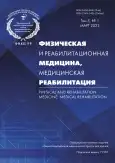Современный подход к реабилитации пациентов с переломами костей нижних конечностей
- Авторы: Бодрова Р.А.1,2, Петрова Р.В.3,4, Делян А.М.1, Преображенская Е.В.3,4, Николаев Н.С.3,4, Гумарова Л.Ш.1,2, Иванов М.И.3, Камалеева А.Р.2
-
Учреждения:
- Городская клиническая больница № 7
- Казанская государственная медицинская академия ― образовательный филиал Российской медицинской академии непрерывного профессионального образования
- Федеральный центр травматологии, ортопедии и эндопротезирования
- Чувашский государственный университет имени И.Н. Ульянова
- Выпуск: Том 5, № 1 (2023)
- Страницы: 40-51
- Раздел: ОРИГИНАЛЬНОЕ ИССЛЕДОВАНИЕ
- URL: https://journal-vniispk.ru/2658-6843/article/view/132844
- DOI: https://doi.org/10.36425/rehab233510
- ID: 132844
Цитировать
Полный текст
Аннотация
Обоснование. Показатели общего травматизма в Российской Федерации имеют тенденцию к росту в большинстве федеральных округов. Пациенты с переломами костей нижних конечностей составляют 8,5–25% от общего числа пострадавших с переломами костей опорно-двигательного аппарата. Для переломов костей нижних конечностей характерны длительные сроки срастания, стойкие контрактуры, нарушение конгруэнтности суставных поверхностей и изменение биомеханики ходьбы. Только полноценная реабилитация позволяет предотвратить эти осложнения и восстановить прежнюю двигательную активность.
Цели исследования ― анализ структуры травм у пациентов травматологического отделения одной из клиник; алгоритм организации медицинской реабилитации и результаты восстановления пациентов с переломами костей нижних конечностей на клиническом примере.
Материалы и методы. Проведён ретроспективный анализ статистических данных о 995 пациентах травматологического отделения № 1 ГАУЗ «Городская клиническая больница № 7» г. Казани, которым выполнена 981 операция. Рандомным методом отобраны две группы пациентов: I (n=45) ― основная и II (n=45) ― контрольная. После лечения в травматологическом центре пациенты группы II проходили медицинскую реабилитацию амбулаторно по месту жительства, пациенты группы I ― в условиях отделения медицинской реабилитации для пациентов с патологией периферической нервной и костно-мышечной систем в ГАУЗ ГКБ № 7 г. Казани. В условиях стационара комплексная программа реабилитации включала лечебную физкультуру, механотерапию, занятия на реабилитационных тренажёрах, кинезитерапевтическую методику PNF (проприоцептивная нейромышечная фасилитация) и др.
Результаты. Более выраженная статистически значимая положительная динамика по окончании курса медицинской реабилитации отмечена у пациентов группы I (уменьшение болевого синдрома по визуальной аналоговой шкале, увеличение мобильности сустава по шкале оценки функции коленного сустава KSS, снижение степени зависимости от окружающих по шкале реабилитационной маршрутизации, повышение индекса мобильности Ривермид, а также способности по поддержанию положения тела в пространстве, улучшение функций ходьбы, поднятия и переноса объектов, частичного ухода за телом). У пациентов группы I также в большей степени отмечена динамика двигательных функций и психоэмоциональной сферы, согласно критериям Международной классификации функционирования, ограничений жизнедеятельности и здоровья.
Заключение. Эффективность представленного алгоритма организации медицинской реабилитации пациентов с переломами костей нижних конечностей подкреплена результатами исследования, показавшего, что у пациентов основной группы (I) отмечалось более значительное улучшение функций, активности и участия, снижение степени ограничения жизнедеятельности по сравнению с группой II, проходившей амбулаторный курс реабилитации (р <0,1).
Полный текст
Открыть статью на сайте журналаОб авторах
Резеда Ахметовна Бодрова
Городская клиническая больница № 7; Казанская государственная медицинская академия ― образовательный филиал Российской медицинской академии непрерывного профессионального образования
Email: bodrovarezeda@yandex.ru
ORCID iD: 0000-0003-3540-0162
SPIN-код: 1201-5698
д.м.н., доцент
Россия, 420103, Казань, ул. Маршала Чуйкова, д. 54; КазаньРоза Васильевна Петрова
Федеральный центр травматологии, ортопедии и эндопротезирования; Чувашский государственный университет имени И.Н. Ульянова
Email: rpetrova@orthoscheb.com
ORCID iD: 0000-0002-2572-5070
SPIN-код: 1555-1352
Россия, Чебоксары; Чебоксары
Артур Маркосович Делян
Городская клиническая больница № 7
Email: gkb7@bk.ru
ORCID iD: 0000-0002-2328-7679
SPIN-код: 6958-9179
Россия, 420103, Казань, ул. Маршала Чуйкова, д. 54
Елена Васильевна Преображенская
Федеральный центр травматологии, ортопедии и эндопротезирования; Чувашский государственный университет имени И.Н. Ульянова
Email: alenka_22@bk.ru
ORCID iD: 0000-0003-3556-145X
SPIN-код: 1525-3912
Россия, Чебоксары; Чебоксары
Николай Станиславович Николаев
Федеральный центр травматологии, ортопедии и эндопротезирования; Чувашский государственный университет имени И.Н. Ульянова
Email: nikolaevns@mail.ru
ORCID iD: 0000-0002-1560-470X
SPIN-код: 8723-9840
д.м.н., профессор
Россия, Чебоксары; ЧебоксарыЛяйсян Шамиловна Гумарова
Городская клиническая больница № 7; Казанская государственная медицинская академия ― образовательный филиал Российской медицинской академии непрерывного профессионального образования
Email: lyaisan@inbox.ru
ORCID iD: 0000-0002-5276-5107
SPIN-код: 7624-4490
к.м.н., доцент
Россия, 420103, Казань, ул. Маршала Чуйкова, д. 54; КазаньМихаил Илларионович Иванов
Федеральный центр травматологии, ортопедии и эндопротезирования
Email: mivanov@orthoscheb.com
ORCID iD: 0000-0001-9852-7086
SPIN-код: 1777-6152
Россия, Чебоксары
Айгуль Рамилевна Камалеева
Казанская государственная медицинская академия ― образовательный филиал Российской медицинской академии непрерывного профессионального образования
Автор, ответственный за переписку.
Email: aigul.kamaleeva@mail.ru
ORCID iD: 0000-0001-7146-4353
SPIN-код: 3683-0680
Россия, 420103, Казань, ул. Маршала Чуйкова, д. 54
Список литературы
- Губин А.В., Соломянник И.А., Очкуренко А.А., и др. Травматизм, ортопедическая заболеваемость, организация травматолого-ортопедической помощи в Российской Федерации в 2019 году / под ред. С.П. Миронова. Москва, 2021. 385 с.
- Бухарин В.А., Крысюк О.Б., Слухай С.И. Применение современных методов реабилитации при переломах нижних конечностей // Ученые записки университета Лесгафта. 2014. № 3. С. 43–45. doi: 10.5930/issn.1994-4683.2014.03.109.p43-45
- Шляпников С.А., Склизков Д.С., Батыршин И.М., и др. Использование метода локального отрицательного давления при лечении некротизирующей инфекции мягких тканей // Альманах Института хирургии им. А.В. Вишневского. 2017. № S1. С. 1078–1079.
- Purcell R.L., Donohue M.A., Saxena S.K., et al. Combat-related acetabular fractures: Outcomes of open versus closed injuries // Injury. 2018. Vol. 49, N 2. Р. 290–295. doi: 10.1016/j.injury.2017.11.035
- Kertzman P.F., Fucs P.M. Does radial shock wave therapy works in pseudarthrosis? Prospective analysis of forty four patients // Int Orthop. 2021. Vol. 45, N 1. Р. 43–49. doi: 10.1007/s00264-020-04778-5
- Rees S., Tutton E., Achten J., et al. Patient experience of long-term recovery after open fracture of the lower limb: A qualitative study using interviews in a community setting // BMJ Open. 2019. Vol. 9, N 10. Р. e031261. doi: 10.1136/bmjopen-2019-031261
- Шакула А.В., Требина Н.П., Косов В.А., Свист Н.В. Методические аспекты развертывания центра медицинской реабилитации на базе военной санаторно-курортной организации // Физическая и реабилитационная медицина, медицинская реабилитация. 2021. Т. 3, № 4. С. 393–398. doi: 10.36425/rehab77963
Дополнительные файлы












